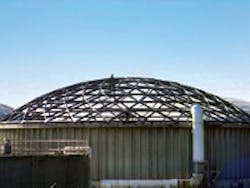About the author: Linc York is an engineering sales representative for Induron. York can be reached at [email protected] or 314.267.1126.
For the past couple of decades, municipalities across the U.S. have been “closing the lid” on wastewater treatment plants. This process has resulted in sewage treatment facilities that both look and smell much better than their predecessors. Because of the chemistry involved in sewage treatment, water plus hydrogen sulfide equals ultra-corrosive sulfuric acid. Furthermore, the presence of acidothiobacillus in oxygen-poor environments—such as closed sewage facilities, which actually converts hydrogen sulfide into sulfuric acid—only magnifies the corrosion problem.
Ceder Rapids Battles Corrosion
When the city of Cedar Rapids, Iowa, needed to replace the aluminum containment dome on its 87 million-gal-per-day wastewater treatment facility roughing filter, the city knew it had a big job to do. The filter—140 ft in diameter and 30 ft tall—was deteriorating because of the aforementioned corrosive gasses. Without the proper protective coatings, the aluminum and concrete structures would corrode at an unacceptably rapid rate, eventually causing a big, expensive failure.
The HR Green engineering team in Cedar Rapids put together a specification for the protective coatings aspect of this high-profile project. In addition to strenuous surface preparation standards, they called for Induron’s Ceramasafe 90, a coating system that could be applied over aluminum and concrete to resist the acidic environment. Induron was able to offer competitive pricing alongside a five-year warranty, and won the contract. In fact, the city of Cedar Rapids has bid out this identical project three times for three different aluminum-domed treatment plant structures, and Ceramasafe 90 was selected by the contractor each time.
Convenience & Durability
Ceramasafe 90 is a 90% volume solids, low-VOC ceramic modified epoxy coating with an ultra-low permeability rate and excellent chemical resistance to hydrogen sulfide, as well as many other chemicals. The ceramic epoxy allows for minimal undercutting and self-heals pinholes and/or spot corrosion. It can be applied in a single-spray application up to 50 mils dry film thickness. The company recommended 25 mils for aluminum and 40 mils for concrete—an unrivaled film build.
The product also is durable. “Ceramasafe 90 seems to act like an exoskeleton for the concrete restoration and geodesic dome,” said Derek Chaplin, construction contract administrator for the Utilities Department of the city of Cedar Rapids. “When the product cures, it is very hard and durable, providing desirable traits for such an abusive environment.”
Ceramasafe 90’s ceramic modification provides additional benefits. Particularly important is edge build. Some coatings may only provide about 30% to 40% of their specified thickness on edges. Ceramasafe 90 was measured consistently at more than 30 mils on the structural edges.
Additionally, this coating system has non-ablative properties, meaning that the aforementioned acidothiobacillus bacteria that creates sulfuric acid and contributes to corrosion cannot grow on this ceramic epoxy.
As often is the case, cost was important to the project managers in Cedar Rapids. The coating system saves time and money because it can be applied in one coat instead of multiple coats, and it does not require special painting equipment.
“Ceramasafe 90 allowed us to apply the specified mils in a single application with a single product,” said Cliff Mohling of Pospisil Painting. “The material saved us many hours of down time waiting for dry times, as compared with multiple coat systems consisting of separate primer and topcoat.”
The Cedar Rapids team was regarded as detail oriented, rigorous and exacting. The HR Green engineering team had to take on the responsibility of providing the client with a proven system that will protect its assets. The general contractor, Tricon Construction, had the oversight responsibility to furnish the extensive labor requirements and project coordination to complete the project on time and on budget. The painting contractor, Pospisil Painting, had to work many days at temperatures of 100°F to complete the abrasive blasting and coatings application to the structural components of the dome so that they did not hold up any other part of this project. Independent inspection company Dixon Eng. kept pace by documenting and measuring the surface profile, dry film thickness, Elcometer adhesion, and holiday detection and correction on more than 800 structural and miscellaneous components.
Installation in Action
To begin the process, the old, corroded dome was removed. The new aluminum dome was fabricated and shipped to the painting contractor’s yard. It looked like an Erector Set while they were working on it. The Pospisil team sandblasted more than 500 structural members and more than 300 miscellaneous pieces before applying Ceramasafe 90. Dixon Eng. inspected every piece for the proper dry film thickness and to ensure that no holidays or pinholes were missed. The dome then was transported in pieces to the jobsite, where it was erected by the construction crew and re-inspected.
Meanwhile, the concrete base was sandblasted and then coated as well. The entire process took about five months from beginning to end.
The city of Cedar Rapids required that the coating manufacturer be on site to inspect the project as it progressed. It asked that Induron oversee the first 25% of the work, and then follow up at 50% completion, 75% completion and 100% completion. At its completion, Dixon Eng. inspected the preparation, coating application and adhesion, and ensured that the film was holiday free, with no pinholes. In essence, it had to assure the city that the job was as close to perfect as possible.
In the end, the city of Cedar Rapids was happy with the results. The project was completed on time and on budget, which is a win-win for everyone.
Download: Here
